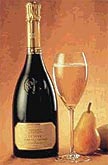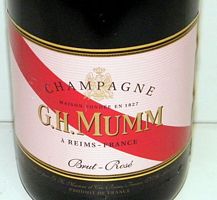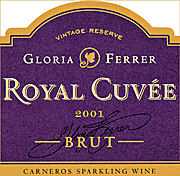As I rummaged through the wine cellar to pull together a charitable silent auction item appropriately dubbed "Holiday Bubbles" in the auction program, it suddenly occurred to me that with each bottle I chose I had a specific type of social event in mind.
 For the casual aperitif prior to an evening on the town, I reached instinctively for an inexpensive but delicious Italian prosecco. Thinking about serving savory appetizers in front of the fire on a crisp winter day, I went for an interesting Spanish cava.
For the casual aperitif prior to an evening on the town, I reached instinctively for an inexpensive but delicious Italian prosecco. Thinking about serving savory appetizers in front of the fire on a crisp winter day, I went for an interesting Spanish cava.
As I conjured up a dressy, festive holiday buffet, I couldn’t resist a non-vintage brut Champagne, and so on.
"Sparkling" is indeed a diverse category of wine, often encompassing wines with little in common other than the fizz. Just about every wine producing region in the world makes wine with bubbles.
So with that in mind, I will begin with the most basic — and misunderstood — fact about sparkling wine: All Champagne is sparkling wine, but not all sparkling wine is Champagne. To qualify as Champagne, a sparkling wine must be produced within the strict boundaries of the Champagne district northeast of Paris.
There is a tendency to call all bubbly "Champagne" no matter its origin, but that is simply not the case. Sparkling wines produced in other parts of France are typically labeled cremant, and the birthplace of all sparkling wine, the Abbey of St. Hilaire in southern France’s Languedoc region, makes the superb blanquette de Limoux.
 Italy also is a prolific producer of bubbly, with everything from the sweet red sparkler, Brachetto d’Acqui (made in the Piedmont region, where Barolo and Barbaresco are the king and queen), to exquisite methode champenoise-style bubblies from Franciacorta, a region that lies between Milan and Venice in northern Italy. Italy is famous, too, for its sweet Asti spumante and prosecco, an increasingly popular sparkling wine from the Veneto region.
Italy also is a prolific producer of bubbly, with everything from the sweet red sparkler, Brachetto d’Acqui (made in the Piedmont region, where Barolo and Barbaresco are the king and queen), to exquisite methode champenoise-style bubblies from Franciacorta, a region that lies between Milan and Venice in northern Italy. Italy is famous, too, for its sweet Asti spumante and prosecco, an increasingly popular sparkling wine from the Veneto region.
Spain has its cava, of course, and the rest of the world relies for the most part on the nomenclature of style, such as brut or extra dry — terms that define the sweetness level of the various sparkling wine styles.
There are still some sparkling wine producers in the U.S. market that insist upon calling their bubbly "Champagne," but that is now the exception rather than the rule.
In keeping with my observation that certain bubbly styles conjure, and consequently match up better, with certain types of social events, I have decided for the purposes of this exercise to group my sparkling wine preferences using just that model.
CASUAL APERITIF
There are numerous opportunities around the holidays to meet up with friends for a brief aperitif after work or a shopping tussle at the mall. For such casual and convivial encounters, prosecco, cava or any of the many cremant wines of France — cremant de Alsace, cremant de Loire, cremant de Limoux (a kissing cousin of blanquette de Limoux) — will serve you well.
These wines are light and easy, but hardly lacking in flavor or character when made well. They have the added benefit of being inexpensive relative to the cost of Champagne or any of the good California bubblies.
TAPAS
 While the cremant-style bubblies can certainly stand up to food, some dishes work best with bubblies that have firmer acid and a little more snap. So when serving savory tapas at a party or ordering in a restaurant, more structured sparkling wines will be more likely to handle the challenge with elan.
While the cremant-style bubblies can certainly stand up to food, some dishes work best with bubblies that have firmer acid and a little more snap. So when serving savory tapas at a party or ordering in a restaurant, more structured sparkling wines will be more likely to handle the challenge with elan.
In that setting, I generally look to non-vintage California bruts and non-vintage brut Champagnes that fall below my price threshold for such occasions, which is about $40 retail, or $65 to $70 at restaurant prices.
If the tapas are both sweet and savory, I might also include "extra dry" bubbly in the mix, for the additional sweetness (indeed, extra dry is sweeter than brut) will match well with tapas that are either on the sweet side or meant to be dipped in a sweet sauce.
It should be noted that there are bone-dry sparkling wines, typically labeled "natural" or "brut zero," but without the dosage (a liqueur that is added at bottling to balance the wine and reduce the acid bite) these wines can be too sharp for many palates.
ELEGANT RECEPTIONS
Glitzy dress-up holiday parties might be the occasion to bring out more upscale non-vintage bruts, non-vintage rose Champagne (more expensive than a simple non-vintage brut) and perhaps even some vintage wines, either from Champagne, California, Italy or Spain.
Other countries have sparklers that might fit into this category, but they are not easily found unless you have access to a large wine market such as New York, Washington, D.C., or Los Angeles.
These bubblies will be more refined and complex, and definitely more compatible, with the more complicated appetizers served at fancy affairs. Rule of thumb: If caviar is being served, the bubblies should be a cut above, or what’s the point?
SIT-DOWN DINNERS
 If you’re ever going to serve vintage Champagne, tetes de cuvee Champagne or any of the prestige cuvees from California that run $50 and up, this would be the time. Structured, complex sparkling wines, particularly those that have been appropriately aged, can be a huge hit at the holiday feasting table.
If you’re ever going to serve vintage Champagne, tetes de cuvee Champagne or any of the prestige cuvees from California that run $50 and up, this would be the time. Structured, complex sparkling wines, particularly those that have been appropriately aged, can be a huge hit at the holiday feasting table.
I’m particularly fond of vintage rose Champagne with roasted game birds, but you would be surprised in general with how well vintage bubbly matches up with just about everything except bloody red meat.
SWEETS
Over the years, I’ve encountered too many fairly savvy wine enthusiasts who simply don’t get sweet bubbly. If you fall into that camp, be aware there is a brave new (not really new) bubbly world out there, and it’s worth experiencing, even if sweet wines are generally not your thing.
Sweet bubblies are meant to be paired with sweet things. Hence the affection Italians have for Asti spumante. In Italy, Asti spumante is served with cakes and cookies, and around the holidays the combination makes for sheer joy.
One of my favorite combinations is brachetto D’acqui with chocolate. Champagne with chocolate — unless the Champagne is a demi-sec — is a huge no-no, but brachetto d’Acqui and chocolate is as sublime as any wine and food pairing could ever be. The brachetto delivers a delicious burst of raspberry fruit that is simply magic with a chocolate sweet.
The beauty, too, of Asti spumante and brachetto and other demi-sec sparkling wines is that they tend to be much lower in alcohol. Brachetto often registers about 7 percent alcohol by volume. Most bruts, for example, check in at between 12.5 and 13.5 percent ABV.
RECOMMENDATIONS
 There are many excellent sparkling wine producers from which to choose, and you are almost always assured of a satisfactory experience if you choose a wine from an established Champagne house or a top California producer.
There are many excellent sparkling wine producers from which to choose, and you are almost always assured of a satisfactory experience if you choose a wine from an established Champagne house or a top California producer.
To somewhat narrow the possibilities, my suggestions today are based upon sparkling wines I have tasted over the past 12 months at various wine competitions.
The big discovery for me in sparkling wine this year has been Sparkling Pointe, a producer from Long Island, N.Y. Sparkling Pointe had the top sparkling wine at the 2011 San Francisco Chronicle Wine Competition and placed two wines in the championship round of the Critics Challenge International Wine Competition. You might have difficulty finding Sparkling Pointe, however, unless you live on the East Coast.
 Another pleasant surprise was Vilarnau, a Spanish cava producer that won Platinum, Gold and Silver awards at the Critics Challenge with wines that retail for less than $20 each. Cavas from Freixenet and Segura Viudas also left their mark at the Sommelier Challenge in September, when Freixenet prevailed with the Best of Class cava.
Another pleasant surprise was Vilarnau, a Spanish cava producer that won Platinum, Gold and Silver awards at the Critics Challenge with wines that retail for less than $20 each. Cavas from Freixenet and Segura Viudas also left their mark at the Sommelier Challenge in September, when Freixenet prevailed with the Best of Class cava.
The Champagne that impressed most in this year’s competitions was G.H. Mumm with its non-vintage Brut Rose ($75), voted Wine of the Year at the 2011 Critics Challenge. Over the past few years, Champagne Mumm has made tremendous strides toward restoring an image that was tarnished somewhat by a lackluster decade or so of production.
From Italy, the proseccos Maschio and Caposaldo piled up the Gold awards at both the Critics and Sommelier Challenges, with wines that retail for $15 or less.
Domestically, the banner-winning wines have been Gloria Ferrer’s vastly improved Royal Cuvee ($35) and the superb prestige cuvee from Domaine Carneros by Taittinger, Le Reve ($90). Both wines have performed consistently with numerous Gold and Platinum awards over the past year.
Follow Robert on Twitter at @wineguru.
8
